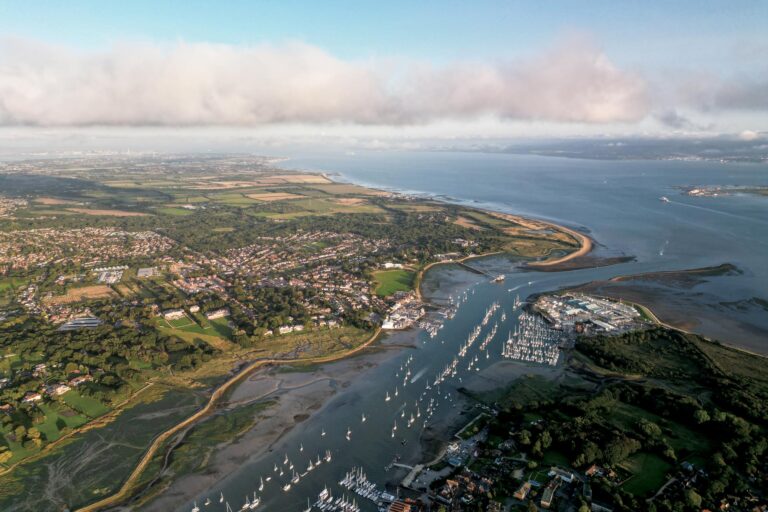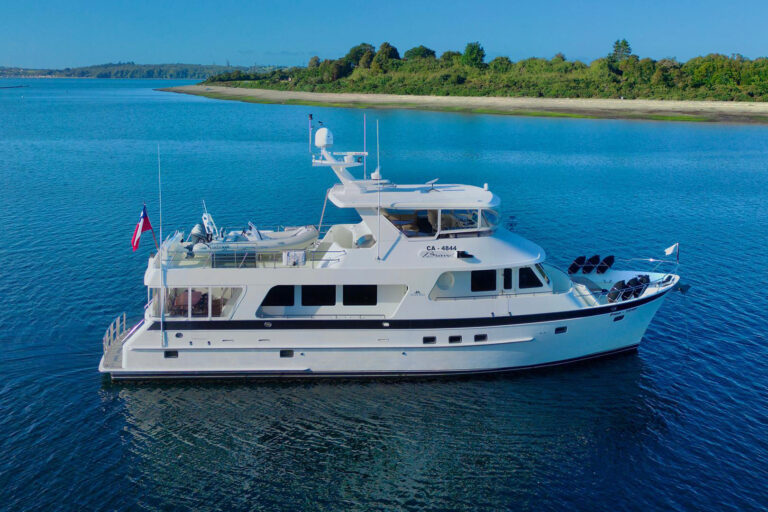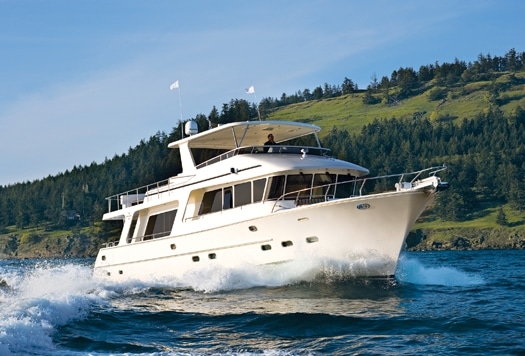
ytgjul09endurance525.jpg
Ancient legend has it that the Thunderbird lived in the Olympia Mountains of what is now Washington State, in a time of bitter cold and torrents of rain, sleet, and snow, and the Quillayute people did not thrive. But when the Chief implored the Great Spirit for help, the Thunderbird, its giant wings making a fierce rumbling and its eyes glowing with fire and lightning, brought them food in the manner of a huge whale held in its terrible claws.
Fast forward to present day, when most everyone knows myths were used by our ancestors to explain misunderstood phenomena, natural or otherwise. So such stories have their basis in fact. And I am a student of the weather, though one focused mostly on avoiding the bad stuff-as most of us are who take to sea.
The ever-present weather-makers in the area around Seattle and Puget Sound-the surrounding Cascade and Olympia mountain ranges, and the Rockies to the east-were still vital meteorological influences on the rather testy early spring day we were to depart. Then, of course, there were the prevailing northwesterly winds sweeping across the wide-open Pacific Ocean, so there was no telling what we would see.
Still, we weren’t taking the easy way. Our journey from Seattle to the San Juan Islands would follow in the hallowed wakes of such Pacific Northwest explorers as Captains Vancouver and Gray, and Lewis and Clark, and I was sure that at some point the land of the Quillayute people would call upon the Thunderbird to throw something our way.
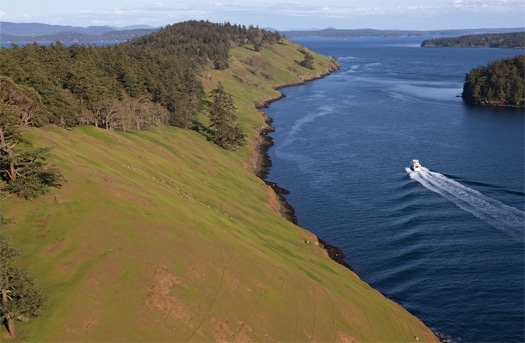
| | |
We were prepared. Our reviewing stand for the parade of weather and breathtaking scenery would be an Endurance 650 Long Range Cruiser from Shanghai-based builder Hampton Yachts. Under the leadership of company chairman Jeff Chen, the yacht was conceived as a tough offshore cruiser capable of runs to the Caribbean or to the wilds of Alaska.
Our crew, assembled at the Hampton Yacht Group’s office on Seattle’s Lake Union, would consist of my colleague Arnie Hammerman, Larry Clark and Robert Fiala of the Hampton Yacht Group, the designer of the yacht, Howard Apollonio, and photographer Neil Rabinowitz.
As we were at the end of a face dock, and with an outgoing tide, we merely took in our lines and let the boat drift off the dock before putting her twin 873-horsepower Caterpillar C18s in gear. But the 650 LRC is equipped to simplify docking in unfamiliar locations and dicey conditions, thanks to standard bow and stern thrusters. Port and starboard stations on the afterdeck also make for easy maneuvering in close.
As Mt. Rainier’s snow-capped peak watched over us from the southeast, we slow-belled across Lake Union and into the Fremont Cut, part of the Lake Washington Ship Canal that links the lake to Puget Sound. Before exiting out into the Sound, we would first have to lock-through the westbound Hiram M. Chittenden Locks. With three boats in the eastbound lock, and Clark holding us steady in the seaway, I stowed my gear and wandered around the Endurance 650 LRC.
The interior of this yacht is beautiful to look at, and its design takes full advantage of the space to provide maximum living, stowage, and entertainment areas. Whether in the salon, galley, or pilothouse, I found myself surrounded by finely crafted woodwork of African Makore cherry, and comfortable and spacious accommodations.
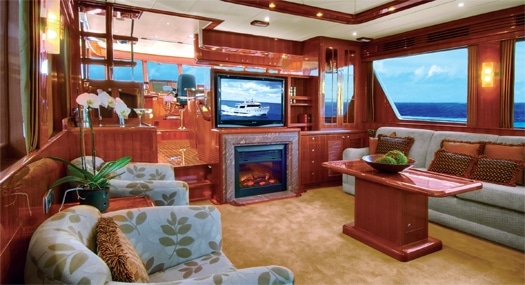
| | |
“Every piece of wood you see aboard is from the same tree,” said Fiala as we looked around the galley and pilothouse area, noting the excellent sightlines into the seaway both ahead, to the sides, and even aft out the sliding glass doors.
“Boat design is a perfect blend of science and art,” said Apollonio as we discussed the process of designing the Endurance series to be safe, comfortable, and practical offshore coastal cruising boats.
The artful design of that joinery meets the science of durability that is built into the Endurance hull. The first three layers of the hull’s laminate schedule utilize vinylester resins and glass. The next two layers are Kevlar, which is also used in three layers in the forward collision zone as well as in the shaft area. The stringers are all solid glass.
“We tab in our athwartships stringers over the fore and aft ones, up the hull sides, and then completely glass everything in to form a unitized body,” added Fiala. “After that, it’s all sanded smooth and gelcoated.” The hull and deck joints are sealed with three layers of glass in six-inch strips to create a unitized construction. The hulls are cored from six inches above the waterline. And the Kevlar goes from chine to chine, also six inches above the waterline. The house and bridge are cored and the interior soles are six to eight inches thick to accommodate a sandwich construction of fiberglass and sound-deadening insulation.
A stairway on the aft port side of the salon took me into the spacious crew quarters, which are finished with the same level of detail as the rest of the boat. For owners not planning on cruising with a crew, this area could be outfitted as a great teenage hangout or VIP area. There is additional access through the stern.
Through the crew area I found access to the engineroom, a user-friendly space that will make all necessary maintenance easy on the knuckles, elbows, and knees. In addition to the excellent headroom, every critical system, pump, valve, or switch is readily accessible.
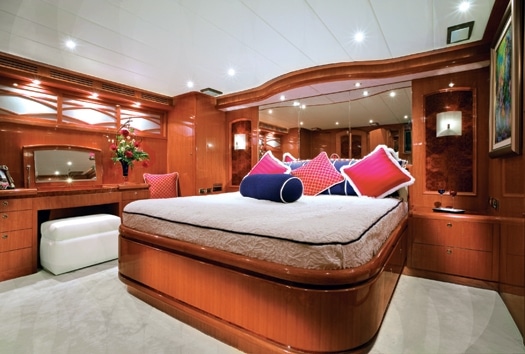
| | |
I was about to visit the accommodations deck, with its three-stateroom, two-head layout, when Hammerman, coming down from topside via the interior stairway, urged us outside.
“You should take a look at this,” he said. At last, I thought: Time to batten down the hatches and put the Endurance in some big water. The Thunderbird was making an appearance! Instead we were greeted by calm seas and the majestic beauty of the Olympias glinting in the sun.
Resigned to my fate of not seeing an ominous sky, cresting combers, and windswept spray, I joined the others on the bridgedeck and enjoyed the warm sun and awesome scenery from my perch in the comfortable starboard seating area. While there would not seem to be any “Victory at Sea” experiences in the offing today, this felt like a win for the good guys.
Clark had been running at an easy 18 knots turning 2000 rpm. We passed the west side of Whidbey Island, and now, as we cruised by the serene lower portion of the Strait of Juan de Fuca and up along Cattle Pass, I could see all the way to the Canadian Gulf Islands, with nary a trace of the Thunderbird in sight. Entering the San Juan Islands, we left Lopez Island to starboard and San Juan Island-with a national historical park on its lower extremity to port, reminding us of the dispute over the island between the U.S. and Great Britain in the mid-1800s.
Pressing northward, we skirted past the entrance to Friday Harbor to port and Wasp Passage, Crane Island, and Deer Harbor Bay to starboard. We rounded the northern end of San Juan Island and skirted Spieden Island with its steep slopes dotted with herds of wild goats.
As beautiful as our day was, we knew those goats were hardy creatures- the sun doesn’t always glister on the waters between these islands. The only thing reliable about the conditions is that they can change and the proximity of the northern Pacific means it can happen in the blink of an eye. But the knowledge that the Thunderbird may be looming around the next bluff made our choice of vessel that much more sensible.
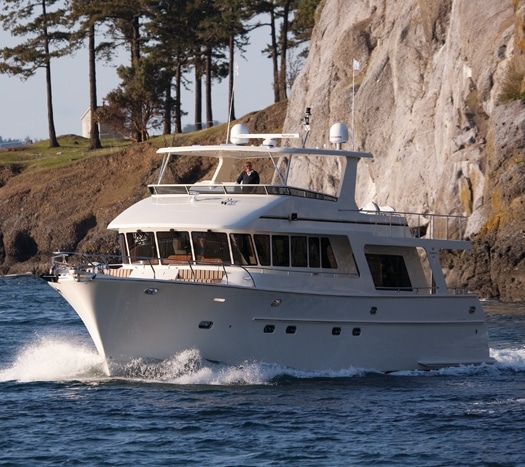
| | |
“We designed and built the Endurance series to exceed the U.S. Coast Guard and International IMO requirements for open-ocean service,” Apollonio said. Her performance in rougher sea states than those we saw was important to both Chen and her designer, and extensive tank testing and stability tests were done to achieve the desired results. But sometimes that stability comes at a cost-higher fuel bills is one example.
“Designing solutions to fit problems was most important,” Apollonio said, adding that while it is difficult to make a slow boat go fast, it is much easier to make a fast one go slow. “Making it efficient is the key.” If an owner wanted to throttle back and cruise at 9 knots, Hampton estimates that the Endurance 650 will have a range of 1,800 nautical miles. But on shorter cruises, where time aboard is brief, Hampton estimates that a 14- knot cruise will produce a range of 450 nautical miles.
To get the range Chen and company wanted, Apollonio’s design calls for a versatile split chine design. “There is a shortcoming with conventional hulls in respect to wavemaking resistance,” Apollonio said. “Instead, the Endurance hull has a division of the forward chine into upper and lower parts. The result is a reduction in the effect of bow waves while the vessel retains its dynamic lift and spray control.”
As the day drew to a close, we headed to the Roche Harbor Marina and Resort for our night’s layover. Tomorrow, at dawn, we would be taking her out again for some more photography and exploring after which I would be heading back to Seattle via a float plane and the Endurance would be pushing on for some additional shooting. But for now, after getting the boat squared away, we settled in at the bar at the marina’s Medrona Grill for some dinner and the camaraderie of my fellow travelers.
The next day dawned bright and sunny and we left the dock to explore the natural beauty of the area. The sun lit up the snow-capped summit of Mt. Baker as it shouldered its way through the clouds around its peak. A lone seal approached the boat, took a quick look, and slipped its sleek body beneath the quiet water.
The weather had some movement, and the colors of land, sea and sky began to shift. The Cascades also made an appearance, their jagged peaks now commanding a great deal of sky. And whether the Thunderbird was going to appear, we didn’t worry about it. After all, we were enjoying the views from the Endurance 650, and she seemed right at home.
Hampton Yachts, (949) 673-6300; **www.hamptonyachtgroup.com**





